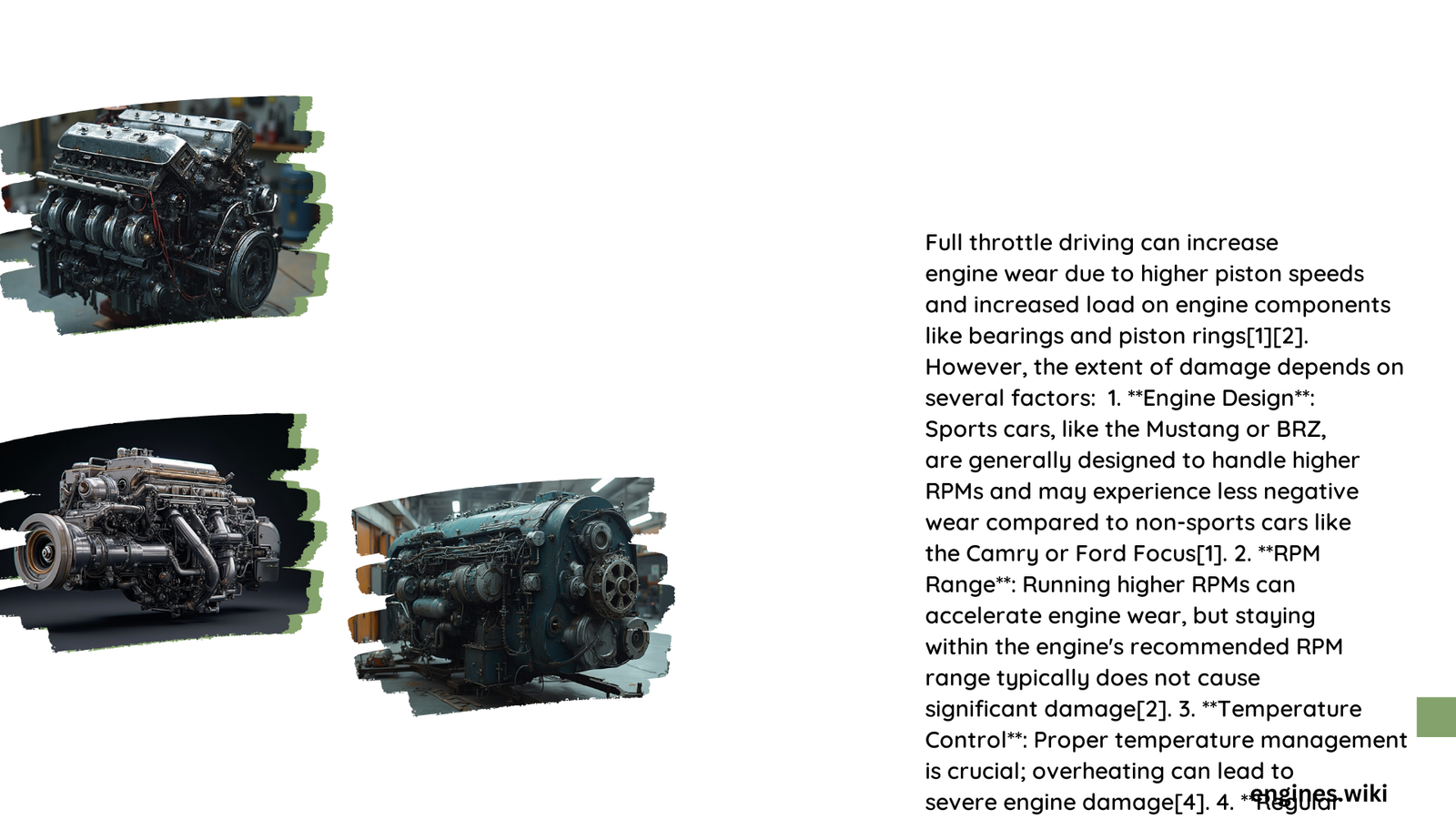Full throttle operation can potentially damage an engine over time due to increased mechanical and thermal stresses. While modern engines are designed to withstand short periods of full throttle use, prolonged or frequent operation at maximum power output can accelerate wear and tear on various components. This article explores the effects of full throttle driving on engine longevity, performance, and maintenance requirements.
What Are the Specific Mechanical Stresses at Full Throttle?
When an engine operates at full throttle, it experiences significant mechanical stresses:
- Increased Piston Forces: The pistons endure higher forces due to increased combustion pressure.
- Connecting Rod Stress: The connecting rods experience greater tension and compression forces.
- Crankshaft Load: The crankshaft bears increased rotational and bending stresses.
- Valve Train Stress: Valves and valve springs undergo more rapid and forceful movements.
These stresses can be quantified:
- In a typical passenger car engine, piston forces can exceed 50,000 N at full throttle.
- Connecting rod stress can reach up to 300 MPa in extreme cases.
- Crankshaft bearings may experience loads of 5,000 N or more.
How Does Full Throttle Affect Engine Temperature?

Full throttle operation significantly impacts engine temperature:
- Combustion Chamber Heat: Temperatures can exceed 2,000°C during peak combustion.
- Exhaust Gas Temperature: Can reach up to 900°C in gasoline engines.
- Engine Oil Temperature: May increase by 20-30°C above normal operating temperature.
- Coolant Temperature: Can rise to near boiling point if not properly managed.
| Engine Component | Normal Temperature | Full Throttle Temperature |
|---|---|---|
| Combustion Chamber | 700-900°C | 2,000-2,500°C |
| Exhaust Gases | 300-400°C | 800-900°C |
| Engine Oil | 90-105°C | 110-135°C |
| Coolant | 85-95°C | 100-110°C |
What Are the Long-Term Effects of Frequent Full Throttle Use?
Frequent full throttle operation can lead to several long-term effects:
- Accelerated Wear: Engine components experience faster wear due to increased friction and heat.
- Reduced Engine Lifespan: Overall engine life may be shortened by 20-30% with regular full throttle use.
- Increased Oil Consumption: Higher temperatures can lead to more rapid oil breakdown and consumption.
- Potential for Catastrophic Failure: Risk of major component failure increases, such as piston ring breakage or bearing seizure.
How Does Full Throttle Impact Fuel Efficiency?
Full throttle operation significantly affects fuel efficiency:
- Fuel consumption can increase by 30-50% compared to normal driving.
- At full throttle, an engine may consume 0.5-1 liter of fuel per minute, depending on size and power output.
- Extended full throttle use can result in a 20-30% reduction in overall fuel economy.
What Maintenance Practices Are Recommended for Engines Frequently Operated at Full Throttle?
To mitigate the effects of frequent full throttle use, consider these maintenance practices:
- More Frequent Oil Changes: Change oil every 3,000-5,000 miles instead of the standard 7,500-10,000 miles.
- Regular Coolant Checks: Inspect and replace coolant more frequently to maintain optimal cooling performance.
- Increased Inspection Intervals: Perform thorough inspections every 10,000-15,000 miles for signs of accelerated wear.
- Upgraded Components: Consider installing high-performance parts designed for increased stress and heat.
- Engine Tuning: Regular engine tuning can help optimize performance and reduce unnecessary stress.
Are There Any Benefits to Occasional Full Throttle Operation?
While frequent full throttle use can be detrimental, occasional use may have some benefits:
- Carbon Deposit Removal: High RPM operation can help clear carbon deposits from engine components.
- Oil Circulation: Full throttle use can promote better oil circulation, reaching all engine parts.
- Performance Verification: It allows drivers to verify that the engine is capable of full power output.
However, these benefits do not outweigh the potential risks of regular full throttle operation.
How Can Drivers Minimize Engine Damage While Still Enjoying Performance?
To balance performance and engine longevity:
- Limit full throttle use to short bursts (10-15 seconds maximum).
- Allow the engine to cool down after high-performance driving.
- Invest in high-quality synthetic oils designed for high-temperature operation.
- Consider installing an oil cooler for better temperature management.
- Monitor engine parameters closely, especially during high-performance driving.
By following these guidelines, drivers can enjoy the performance of their vehicles while minimizing the risk of engine damage from full throttle operation.
References:
1. https://www.physicsforums.com/threads/analysis-of-thermal-and-pressure-stresses-in-y-exhaust.490714/
2. https://www.mdpi.com/1996-1073/16/21/7400
3. https://btstu.researchcommons.org/cgi/viewcontent.cgi?article=1238&context=journal
